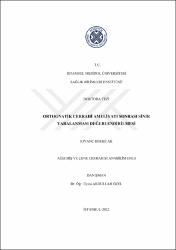| dc.contributor.advisor | Özel, Abdullah | |
| dc.contributor.author | Ak, Kıvanç Berke | |
| dc.date.accessioned | 2023-12-14T11:29:37Z | |
| dc.date.available | 2023-12-14T11:29:37Z | |
| dc.date.issued | 2022 | en_US |
| dc.date.submitted | 2022-07-27 | |
| dc.identifier.citation | Ak, K. B. (2022). Ortognatik cerrahi ameliyatı sonrası sinir yaralanması değerlendirilmesi. (Yayımlanmamış doktora tezi). İstanbul Medipol Üniversitesi Sağlık Bilimleri Enstitüsü, İstanbul. | en_US |
| dc.identifier.uri | https://tez.yok.gov.tr/UlusalTezMerkezi/tezSorguSonucYeni.jsp | |
| dc.identifier.uri | https://hdl.handle.net/20.500.12511/12008 | |
| dc.description.abstract | Nörosensörial bozukluk (NSB) ortognatik cerrahi (OC) operasyonunun en sık karşılaşılan komplikasyonlardan biri olup, hastaların yaşam kalitesi açısından yüksek öneme sahiptir. Çalışmada, OC sonrası gelişen sensitif duyu kaybının ve sinir hasarının erken postoperatif dönemde incelenmesi ve iyileşme paterninin gözlenmesi amaçlandı. Dentofasiyal deformite onarımı için İstanbul Medipol Üniversitesi Ağız Diş ve Çene Cerrahisi bölümünde OC operasyonu (Le Fort I Osteotomisi (LF1O), BSSO ve kombinasyonları) geçiren 36 hasta üzerinde çalışıldı. Tüm hastalara nörosensörial testler (NST); preoperatif 10. gün (T0), 1. gün (T1), 1. hafta (T2), 2. hafta (T3), 3. hafta (T4), 1. ay (T5), 2. ay (T6) ve 3. ayda (T7) uygulandı. Periferal sinir hasarı (PSH) derecesinin belirlenmesi amaçlı A sınıfı testlerde; hareket eden fırça yön tayini testi (HFYT), stimulus lokalizasyon belirleme testi (SLBT) ve statik iki nokta ayrım testi (S2NAT) uygulandı. Bu testlerin en az birinde hastada azalmış duyu belirlenmesi durumunda B sınıfı testler uygulandı. B sınıfı testi olarak hafif dokunma testi (HDT) uygulandı. Bu testin sonucunda yine normal olmayan duyu saptanırsa da C sınıfı testlere geçilmiş ve sıcak soğuk ayırım testi (SSAT) kullanıldı. Çalışmada bimaksiller ameliyatların, erken dönemde gelişen somatosensoriyel değişiklikler üzerinde negatif etkisinin olduğu ve bu etkinin genioplastinin de eklendiği kombinasyonda daha da belirgin olduğu bulundu. Sınırlı bölgede gerçekleştirilen ameliyatlarda daha az somatosensoriyel değişiklikler gözlemlendi. Ortognatik cerrahide NSB çalışmaları yapılacaksa, aynı tip ameliyatlar içinde planlanması ve genioplasti ameliyatında IOS iyileşmesi üzerinde olası etkisinin göz önünde bulundurulması önerildi. | en_US |
| dc.description.abstract | Neurosensory disorder (NSD) is one of the most common complications of orthognathic surgery (OS) and has high importance in patients' quality of life. This study aimed to examine the loss of sensory function and nerve damage after OS in the early postoperative period and observe the recovery pattern. Thirty-six patients underwent OS operations (Le Fort I Osteotomy (LF1O), BSSO, and combinations) for dentofacial deformity treatment in the Istanbul Medipol University Department of Oral and Maxillofacial Surgery were studied. Neurosensory tests (NST) were performed on all patients respectively; preoperative 10th day (T0), the first day (T1), first week (T2), second week (T3), third week (T4), first month (T5), second month (T6) and third months (T7). Class A tests were performed to determine the degree of peripheral nerve damage (PND). These; the moving brush stroke identification directional stroke test (MBSIT), stimulus localization test (SLT), and static two-point discrimination test (S2PDT) were applied. Class B tests were applied if the decreased sensation was detected in at least one of these tests. The static light touch test (SLTT) was used as a class B test. Class C tests were performed if the abnormal sensation was detected due to this test, and the thermal discrimination test (TDT) was used. The study found that bimaxillary surgeries had a negative effect on the somatosensory changes that developed in the early period, and this effect was even more pronounced in combination with genioplasty. Less somatosensory changes were observed in the operations performed in the limited area. If NSB studies are to be performed in orthognathic surgery, it may be recommended to plan them in the same type of surgery, and the possible effect on IOS recovery in genioplasty surgery must be considered. | en_US |
| dc.language.iso | tur | en_US |
| dc.publisher | İstanbul Medipol Üniversitesi, Sağlık Bilimleri Enstitüsü | en_US |
| dc.rights | info:eu-repo/semantics/openAccess | en_US |
| dc.subject | Komplikasyon | en_US |
| dc.subject | Nörosensörial Bozukluk | en_US |
| dc.subject | Ortognatik Cerrahi | en_US |
| dc.subject | Sinir Yaralanması | en_US |
| dc.subject | Sinir İyileşmesi | en_US |
| dc.subject | Complication | en_US |
| dc.subject | Neurosensorial Disorder | en_US |
| dc.subject | Nerve Healing | en_US |
| dc.subject | Nerve Injury | en_US |
| dc.subject | Orthognathic Surgery | en_US |
| dc.title | Ortognatik cerrahi ameliyatı sonrası sinir yaralanması değerlendirilmesi | en_US |
| dc.title.alternative | Evaluation of nerve injury after ortognatic surgery | en_US |
| dc.type | doctoralThesis | en_US |
| dc.department | İstanbul Medipol Üniversitesi, Sağlık Bilimleri Enstitüsü, Ağız Diş ve Çene Cerrahisi Ana Bilim Dalı | en_US |
| dc.authorid | 0000-0002-7623-0473 | en_US |
| dc.relation.publicationcategory | Tez | en_US |
| dc.institutionauthor | Ak, Kıvanç Berke | |


















